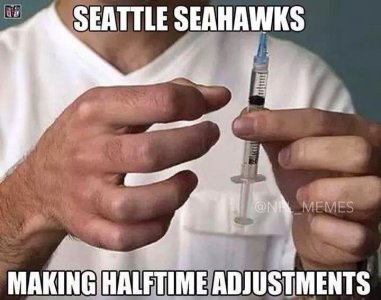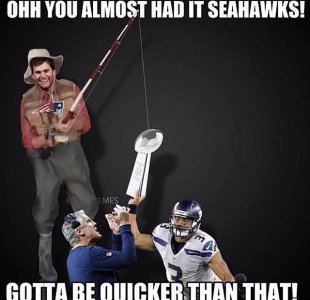nnuut
Moderator | TSP Talk Royalty
- Reaction score
- 210
[h=1]We Computer-Simulated The Deflategate Football Scandal[/h] Yes, the balls were under-inflated. But did it really make much of a difference?
By Sarah Fecht Posted January 29, 2015
Deformation In A 12.5 PSI Football
ANSYS
A comparison of deformations in a 12.5psi football versus a 10.5psi football suggest that the under-inflated footballs didn't give the quarterback a stronger grip.
Last week, after the New England Patriots destroyed the Indianapolis Colts by a whopping 38 points, "anonymous league sources" accused the team of under-inflating footballs. Thus "Deflategate" was born.
With the Patriots set to play the Seattle Seahawks this Sunday at the Super Bowl, the Deflategate controversy hangs heavy in the air. So Popular Science partnered with ANSYS, a company that specializes in computer simulations, to provide yet another perspective on the scandal.
Regulations require footballs to be inflated to a pressure of at least 12.5 pounds per square inch, whereas the Patriots' footballs at half-time measured 10.5 psi. That matters because footballs with less air inside are easier for quarterbacks to grip and control, especially during soggy weather. The implication: The Patriots might have tampered with football pressure to give themselves an advantage. Not cool.
Don't worry, we're mostly steering clear of the argument over how the balls got that way. (Patriots coach Bill Belichick blamed it on the weather and the rough handling of the footballs, whereas others have pointed out that the Colts' footballs experienced the same conditions with no major loss of pressure. Even Bill Nye weighed in on national television.) So far the NFL has made no official decision on the matter.
What we wanted to know is, how much of a difference does two pounds of pressure make, anyway? Could the deflated balls explain how the Patriots managed to wipe the floor with their opponents?
ANSYS used a multiphysics model, which incorporates things like fluid forces, thermal effects, and structural integrity. For this simulation, they plugged in data like the temperature inside and outside the football, air pressure, the behavior of the ball's leather and rubber materials, and more. Then they used the simulation to compare the performance of a 12.5 psi football to a 10.5 psi football.
[h=2]How Much Does It Affect The Grip?[/h] When a quarterback throws a football, having a better grip means the ball will have a tighter spiral. The throw will be more precise and more reliable. So how much does a difference of 2 psi change the strength of the quarterback's grip?
Barry Christenson, ANSYS’s director of product marketing and a Pittsburgh Steeler’s fan, simulated how much more the 10.5 psi ball deforms under a normal grip. He and the rest of the team started by looking at the typical places where the quarterback’s fingers grasp the ball:[more]
We Computer-Simulated The Deflategate Football Scandal | Popular Science
By Sarah Fecht Posted January 29, 2015
Deformation In A 12.5 PSI Football
ANSYS
A comparison of deformations in a 12.5psi football versus a 10.5psi football suggest that the under-inflated footballs didn't give the quarterback a stronger grip.
Last week, after the New England Patriots destroyed the Indianapolis Colts by a whopping 38 points, "anonymous league sources" accused the team of under-inflating footballs. Thus "Deflategate" was born.
With the Patriots set to play the Seattle Seahawks this Sunday at the Super Bowl, the Deflategate controversy hangs heavy in the air. So Popular Science partnered with ANSYS, a company that specializes in computer simulations, to provide yet another perspective on the scandal.
Regulations require footballs to be inflated to a pressure of at least 12.5 pounds per square inch, whereas the Patriots' footballs at half-time measured 10.5 psi. That matters because footballs with less air inside are easier for quarterbacks to grip and control, especially during soggy weather. The implication: The Patriots might have tampered with football pressure to give themselves an advantage. Not cool.
Don't worry, we're mostly steering clear of the argument over how the balls got that way. (Patriots coach Bill Belichick blamed it on the weather and the rough handling of the footballs, whereas others have pointed out that the Colts' footballs experienced the same conditions with no major loss of pressure. Even Bill Nye weighed in on national television.) So far the NFL has made no official decision on the matter.
What we wanted to know is, how much of a difference does two pounds of pressure make, anyway? Could the deflated balls explain how the Patriots managed to wipe the floor with their opponents?
ANSYS used a multiphysics model, which incorporates things like fluid forces, thermal effects, and structural integrity. For this simulation, they plugged in data like the temperature inside and outside the football, air pressure, the behavior of the ball's leather and rubber materials, and more. Then they used the simulation to compare the performance of a 12.5 psi football to a 10.5 psi football.
[h=2]How Much Does It Affect The Grip?[/h] When a quarterback throws a football, having a better grip means the ball will have a tighter spiral. The throw will be more precise and more reliable. So how much does a difference of 2 psi change the strength of the quarterback's grip?
Barry Christenson, ANSYS’s director of product marketing and a Pittsburgh Steeler’s fan, simulated how much more the 10.5 psi ball deforms under a normal grip. He and the rest of the team started by looking at the typical places where the quarterback’s fingers grasp the ball:[more]
We Computer-Simulated The Deflategate Football Scandal | Popular Science



